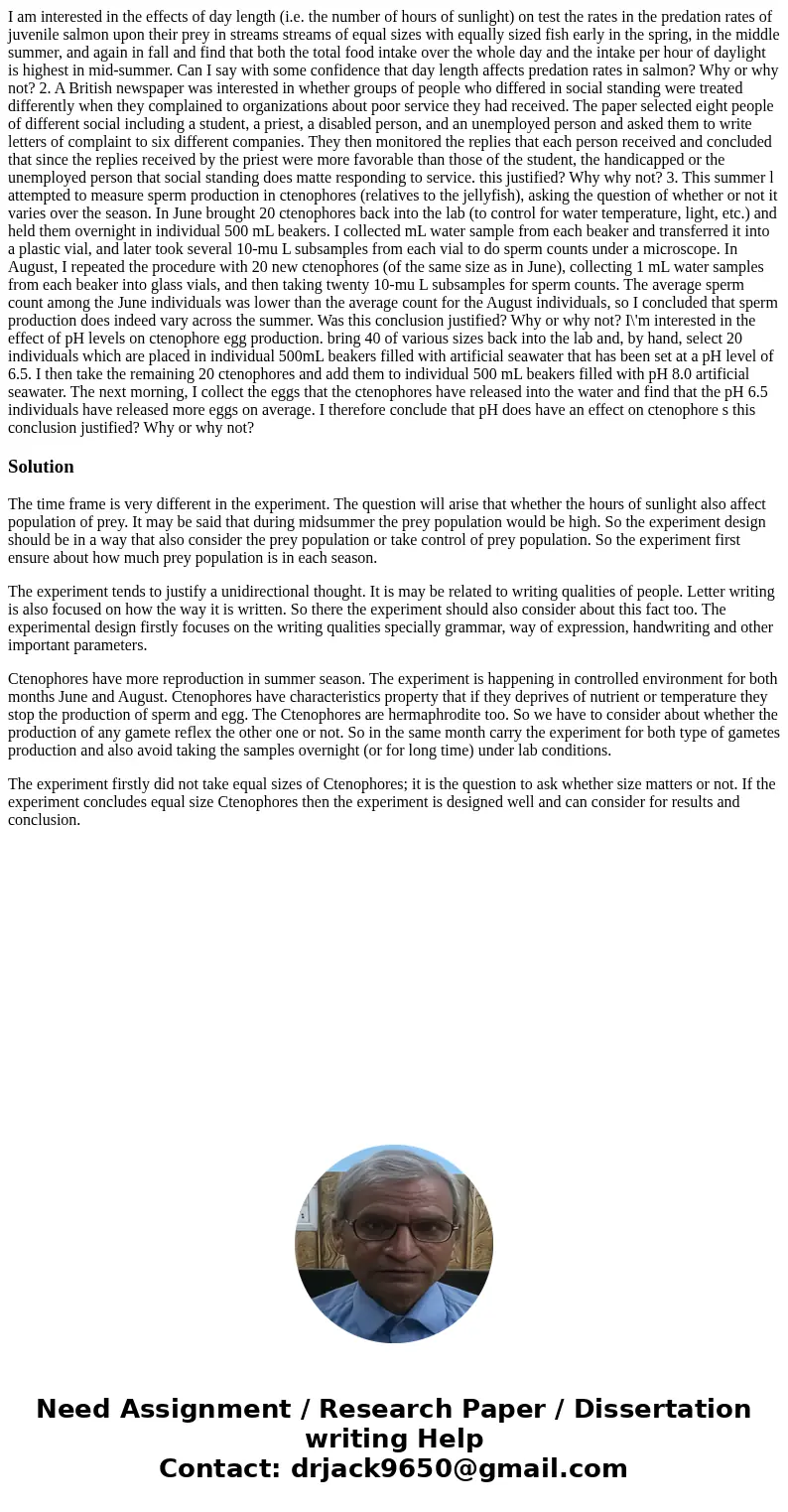I am interested in the effects of day length (i.e. the number of hours of sunlight) on test the rates in the predation rates of juvenile salmon upon their prey in streams streams of equal sizes with equally sized fish early in the spring, in the middle summer, and again in fall and find that both the total food intake over the whole day and the intake per hour of daylight is highest in mid-summer. Can I say with some confidence that day length affects predation rates in salmon? Why or why not? 2. A British newspaper was interested in whether groups of people who differed in social standing were treated differently when they complained to organizations about poor service they had received. The paper selected eight people of different social including a student, a priest, a disabled person, and an unemployed person and asked them to write letters of complaint to six different companies. They then monitored the replies that each person received and concluded that since the replies received by the priest were more favorable than those of the student, the handicapped or the unemployed person that social standing does matte responding to service. this justified? Why why not? 3. This summer l attempted to measure sperm production in ctenophores (relatives to the jellyfish), asking the question of whether or not it varies over the season. In June brought 20 ctenophores back into the lab (to control for water temperature, light, etc.) and held them overnight in individual 500 mL beakers. I collected mL water sample from each beaker and transferred it into a plastic vial, and later took several 10-mu L subsamples from each vial to do sperm counts under a microscope. In August, I repeated the procedure with 20 new ctenophores (of the same size as in June), collecting 1 mL water samples from each beaker into glass vials, and then taking twenty 10-mu L subsamples for sperm counts. The average sperm count among the June individuals was lower than the average count for the August individuals, so I concluded that sperm production does indeed vary across the summer. Was this conclusion justified? Why or why not? I\'m interested in the effect of pH levels on ctenophore egg production. bring 40 of various sizes back into the lab and, by hand, select 20 individuals which are placed in individual 500mL beakers filled with artificial seawater that has been set at a pH level of 6.5. I then take the remaining 20 ctenophores and add them to individual 500 mL beakers filled with pH 8.0 artificial seawater. The next morning, I collect the eggs that the ctenophores have released into the water and find that the pH 6.5 individuals have released more eggs on average. I therefore conclude that pH does have an effect on ctenophore s this conclusion justified? Why or why not?
The time frame is very different in the experiment. The question will arise that whether the hours of sunlight also affect population of prey. It may be said that during midsummer the prey population would be high. So the experiment design should be in a way that also consider the prey population or take control of prey population. So the experiment first ensure about how much prey population is in each season.
The experiment tends to justify a unidirectional thought. It is may be related to writing qualities of people. Letter writing is also focused on how the way it is written. So there the experiment should also consider about this fact too. The experimental design firstly focuses on the writing qualities specially grammar, way of expression, handwriting and other important parameters.
Ctenophores have more reproduction in summer season. The experiment is happening in controlled environment for both months June and August. Ctenophores have characteristics property that if they deprives of nutrient or temperature they stop the production of sperm and egg. The Ctenophores are hermaphrodite too. So we have to consider about whether the production of any gamete reflex the other one or not. So in the same month carry the experiment for both type of gametes production and also avoid taking the samples overnight (or for long time) under lab conditions.
The experiment firstly did not take equal sizes of Ctenophores; it is the question to ask whether size matters or not. If the experiment concludes equal size Ctenophores then the experiment is designed well and can consider for results and conclusion.

 Homework Sourse
Homework Sourse